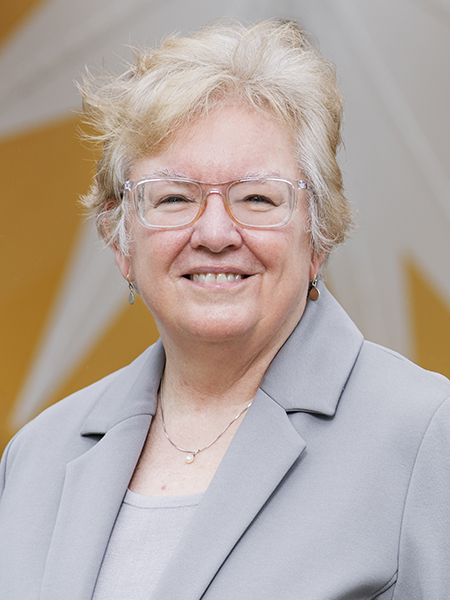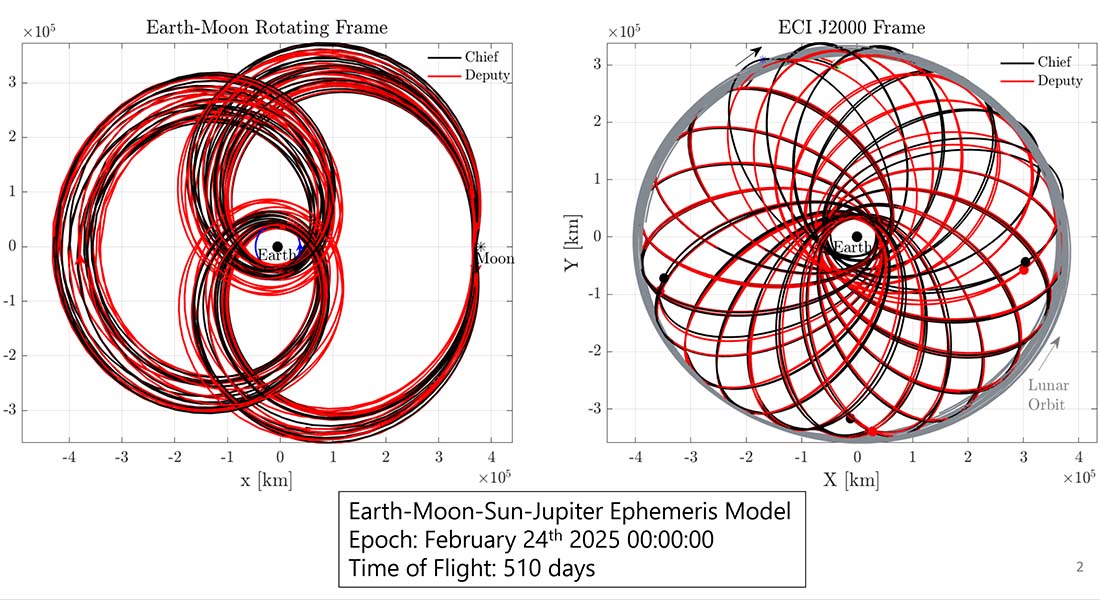AAE's Howell on USAF-funded team to track objects in space
Space is getting to be a busy place, and it’s vital to track the increasing numbers of objects up there as nations and commercial entities launch more and more satellites into orbit. Kathleen Howell is a prominent expert in orbit mechanics, trajectory optimization and spacecraft dynamics and control, and she’s been tapped to put that expertise to use for the Air Force.
Howell, the Hsu Lo Distinguished Professor of Aeronautics and Astronautics in the Purdue School of Aeronautics and Astronautics, is on a team that will be tackling what is known as space domain awareness (SDA) — part of a $5-million grant over five years from the Air Force Research Laboratory’s (AFRL) Office of Scientific Research, through its newly established Space University Research Initiatives (SURI) program. The program is tasked with translating academic research into new military technologies for the U.S. Air Force and U.S. Space Force (USSF).

Howell will be working with Professor John Crassidis of the State University of New York’s University at Buffalo — he submitted the winning proposal, "Space Object Understanding and Reconnaissance of Complex Events (SOURCE)" — along with partners from Pennsylvania State University, Georgia Institute of Technology and Massachusetts Institute of Technology.
“This project goal is to develop fundamental research associated with developing a next-generation SDA framework,” Howell said. “My contribution is focused in the cislunar region of Earth-Moon space. If you think about a sphere around the Earth at approximately the radius of the Moon (~ 384,400 km), it is a huge volume. Trying to continuously survey and locate satellites throughout that entire region is not possible. And SDA does not only mean satellites, of course. They may be other natural objects that need tracking, as well as debris matter.”
The presence and orbital motions of all those objects in space can have repercussions both unintentional and intentional — some may not be designed for benign use — hence the Air Force’s interest. The USSF is charged with tracking these objects so it can alert satellite operators about possible impacts and remain vigilant to threats.
In any region of space, the object trajectory is a fundamental and critical element for any mission. Every vehicle operates in its own unique orbit or trajectory.
“SDA involves collecting sensor data and determining the path of the vehicle,” Howell said.
That may sound straightforward, but it’s far from simple.
“Satellites have been operating in LEO [low-Earth orbit, an altitude of 2,000 km or less] and GEO [geostationary orbit, some 36,000 km above the Earth] for some time, so we have a pretty good sense of what the paths can look like,” Howell said. “However, in cislunar space, we do not actually know — in 2022 — all the possible pathways throughout the region. The gravitational environment as well as the perturbing forces are not sufficiently understood to always predict the orbits/trajectories. Part of my job in the project is to develop a network of connected pathways throughout the region.”

AFRL points out that the challenges mount as the U.S., along with other nations and commercial interests, begin voyaging back to the Moon — adding to the number of objects and volume of space that requires monitoring. Most USSF satellites orbit 36,000 km above the Earth; the Moon is 10 times further out. Orbits may not exactly repeat, as spacecraft motion is affected by gravitational forces from both the Earth and Moon, complicating trajectory dynamics. Tracking thousands of objects on orbit requires advanced detection technologies to identify them, predict their trajectories and get a handle on their nature and intent.
Howell’s team will be developing new analytical and computational approaches, investigating novel sensor modalities and exploring how to fuse different types of information to inform a revolutionary space domain awareness capability. A key element of the project is that the collaborative research will enhance the technical workforce, by involving students as active participants in the research, technology maturation and translation into practice.
Her Purdue team will include her own graduate students working with the faulty and graduate students at the other institutions.
“To accomplish the objective requires a variety of expertise, but also a multi-university team that has already worked well together,” she said. “Our team is diverse in many ways, which brings many different perspectives to the fore — critical for progressing on complex problems. Graduate students at each institution, including Purdue, will also be interacting on the technical aspects. It will greatly benefit all the students, and offer an opportunity to prepare the workforce in this area.”
The grant is another expression of Purdue’s standing in the space community. Purdue is one of the founding members of the new Space Force University Partnership Program, established by the USSF in 2021 to address the engineering, science and technology issues it faces. Purdue was selected for the quality of its STEM degree offerings and space-related research labs and initiatives; its strong Reserve Officers’ Training Corps (ROTC) program; the diversity of its student cohort; and its support for military, veterans and their families in higher education.
Purdue will play another strong role in the orbital economy through its Cislunar Initiative, leveraging strengths in mission design, space domain awareness and propulsion to advance access to cislunar space between the Earth and the Moon. The initiative will focus on utilizing resources from the Moon and near-Earth objects, infrastructure for cislunar space development and habitability, space traffic management, space policy, and defense of the nation’s space-based assets.
“As we move out further into space, we must understand the Earth-Moon neighborhood in all of its dimensions,” Howell said. “Remember, when we think about the space missions of the past, the goal was a short-term visit, and then returning to the planet surface. We are now working on a sustainable human presence. Living and working in space continuously is much different than a short visit. We will need to create a space infrastructure to maintain that presence and contribute to a viable space economy. It is an exciting time, as the entire world is progressing toward this supportable, ongoing presence and a new space economic and use model.”
